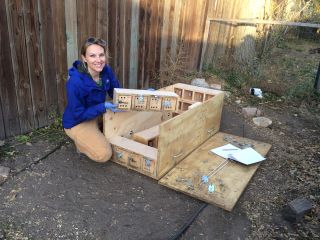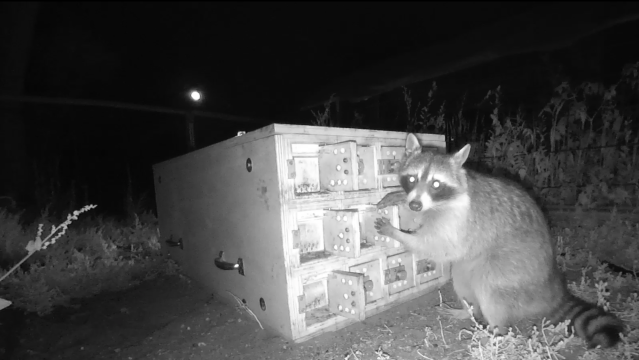Animal Behavior
City Raccoons Are Sophisticated Problem-Solvers
Study suggests raccoons’ cognitive skills may help them adapt to urban living.
Posted July 31, 2024 Reviewed by Lybi Ma
Key points
- Researchers studied wild urban raccoons using puzzle boxes with either one or multiple solutions.
- Raccoons who engaged with the boxes demonstrated flexibility and individuality in problem-solving.
- The inclusion of an easier solution enabled previous non-solver raccoons to become solvers.

Increasing urbanization has crowded out many wild animals. But raccoons appear to be thriving, living in cities across the country and even expanding their historical range.
To investigate what underlies their ability to adapt, Lauren Stanton and her Ph.D. adviser Sarah Benson-Amram combined a brand-new cognitive test for wild raccoons with modern technology. Their findings suggest that raccoons’ problem-solving skills may help them meet the challenges of urban life.
Studying Cognition in the Wild
Benson-Amram had previously used puzzle boxes, in which an animal must figure out how to open a compartment to retrieve food, to probe the problem-solving abilities of hyenas and other large carnivores. However, a new approach was needed to study the urban raccoons of Laramie, Wyoming.
“These raccoons are nocturnal and cryptic. They were not habituated to us. We weren’t going to be able to watch them live,” says Stanton. “We needed a new way to test them that had not been done before.”
Stanton, Benson-Amram, and colleagues designed a new type of puzzle box that had 24 locked compartments containing food instead of a single compartment. This allowed them to collect data from multiple individuals within the same night.

Before the start of testing, the team captured raccoons with humane traps and marked them with passive integrated transponder (PIT) tags. These were injected between the shoulder blades to facilitate individual recognition using radio frequency identification (RFID) techniques.
The researchers set up the puzzle box and surrounded it with a flexible antenna attached to an RFID reader to detect the approach of PIT-tagged raccoons. They also installed multiple infrared home security cameras around the testing area to record all interactions with the puzzle box.
Problem-Solving Skills
Stanton and colleagues began by setting out a 24-door puzzle box in which every door had the same solution.
“For this initial phase, we presented the raccoons with a new problem and asked if they could use innovation to solve it,” says Stanton. “We found that, yes, about a quarter of the raccoons that we tested learned how to open this single-solution puzzle box.”
Additionally, the team noticed an alternative strategy employed by some raccoons. Rather than solving the puzzle box, they waited nearby for another raccoon to open a door and then tried to scrounge the food reward away from them.

The second phase of the experiment involved another 24-door puzzle box, but this one had four different latch types instead of just one.
The raccoons that had previously learned to open the single-solution box quickly generalized their learning to the new types of solutions, demonstrating flexibility in problem-solving. Further analyses showed that raccoons did not open the same sequence of latches every time; instead, they transitioned among the different latch types in a flexible manner. Yet, each raccoon seemed to use an individually distinct sequence when opening compartments. Stanton thinks that sticking to strategies that differ from one another may help the raccoons mitigate competition.
Stanton and colleagues also noted that some of the non-solving raccoons who had previously scrounged off others switched and became solvers themselves when presented with the multi-solution puzzle box. This may be due to the inclusion of an easier solution on the second box. Once exposed to an easier solution that they were able to solve, the previous scroungers seemed to gain some motivation and knowledge to learn the rest of the solution types, says Stanton.
“It speaks to how learning begets learning,” she says.
Getting to Know the Neighbors
Overall, the raccoons in this study demonstrated flexibility and individuality in their problem-solving. But only about a quarter of wild raccoons engaged with the puzzle boxes at all. A similar study with captive raccoons resulted in 65 percent participation.
Stanton says that wild raccoons may be more likely to perceive the puzzle boxes as risky and avoid them altogether. It’s a sound strategy for a species often regarded as a nuisance and exposed to various forms of lethal and non-lethal management. Indeed, many of the raccoons that did interact with the puzzle boxes in this study were juveniles, who tend to be more exploratory and risk-taking than adults.
In addition to highlighting why studies with wild animals in natural environments are important, the results have implications for understanding and living alongside urban raccoons.
With urbanization and human population growth not slowing down anytime soon, Stanton believes that cities must make room for wild residents.
“There is a growing need to restore and design cities with wildlife in mind,” she says. “A better understanding of the behavior and cognition of urban wildlife can help us coexist well with raccoons and other species with which we share our cities.”
References
Stanton LA, Cooley-Ackermann C, Davis EC, Fanelli RE, and Benson-Amram S. 2024. Wild raccoons demonstrate flexibility and individuality in innovative problem-solving. Proceedings of the Royal Society B 291: 20240911. Doi: 10.1098/rspb.2024.0911.




